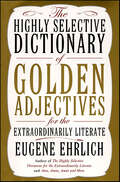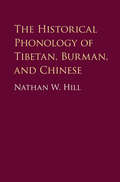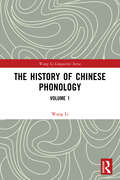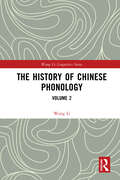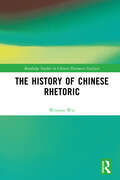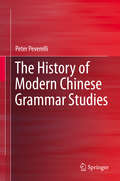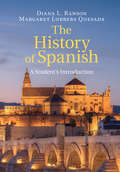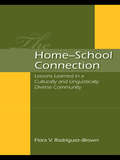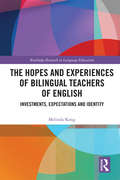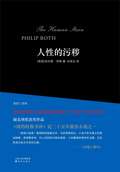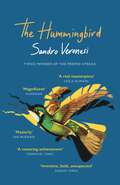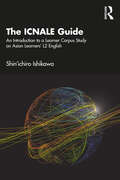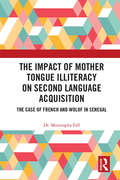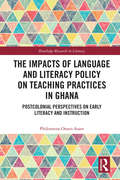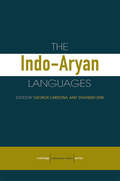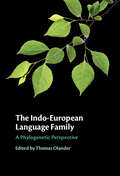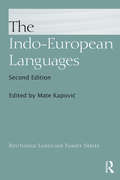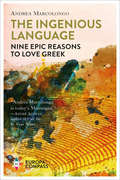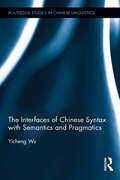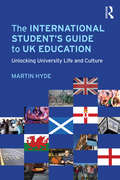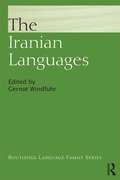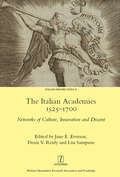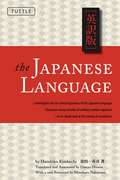- Table View
- List View
The Highly Selective Dictionary of Golden Adjectives: For the Extraordinarily Literate (Highly Selective Reference)
by Eugene EhrlichAdjectives have long suffered from bad press. For many years, English teachers have been fond of telling students that "adjectives are the enemy of nouns, and adverbs are the enemy of everything else."While it's still advisable to heed your English teacher's advice on most other matters, The Highly Selective Dictionary of Golden Adjectives for the Extraordinarily Literate proves that breaking certain rules can make written and spoken language that much livelier, adding much-needed color, style, and adornment. With this addition to the popular Highly Selective series, the "golden" adjective, at last, gets the star treatment it deserves. From adventitious to zaftig, renowned lexicographer Eugene Ehrlich has collected more than 850 of the most interesting and engaging adjectives in the English language and has provided concise definitions and instructive usage examples. Whether you're a writer, a speaker, or a word buff, this compendious, trenchant, laudable, and all-around fantabulous volume will help you put panache back into your prose.
The Historical Phonology of Tibetan, Burmese, and Chinese
by Nathan HillThe discovery of sound laws by comparing attested languages is the method which has unlocked the history of European languages stretching back thousands of years before the appearance of written records, e.g. Latin p- corresponds to English f- (pes, foot; primus, first; plenus, full). Although Burmese, Chinese, and Tibetan have long been regarded as related, the systematic exploration of their shared history has never before been attempted. Tracing the history of these three languages using just such sound laws, this book sheds light on the prehistoric language from which they descend. Written for readers with little linguistic knowledge of these languages, but fully explicit and copiously indexed for the specialist, this work will serve as the bedrock for future progress in the study of these languages.
The History of Chinese Phonology: Volume 1 (Wang Li Linguistics Series)
by Wang LiAs the first volume of a two-volume set on the history of Chinese phonology, this book introduces the basics of the discipline and charts the history of phonology from the pre-Qin period to the Song dynasty.Based on abundant phonological materials, the author divides the history of Chinese phonology into nine historical periods, which helps illuminate its evolutions and principles. The first part of the book explains the fundamental concepts of the history and studies of Chinese phonology, including the rhyme dictionary, the rhyme table, dialect, and methodology, as well as fanqie, rhyme sets, division, and articulation. The second part discusses Chinese phonology across the first six periods, from the pre-Qin era (before 206 BCE) to the Song dynasty (960–1279), elucidating the phonological development and characteristics in terms of initials, rhyme groups, and tones.This title will be of great value for scholars and students studying Chinese phonology, Chinese linguistics, and readers interested in the essence of rhyming behind classic Chinese lyrics, poetry, drama, and other forms of verse.
The History of Chinese Phonology: Volume 2 (Wang Li Linguistics Series)
by Wang LiAs the second volume of a two-volume set on the history of Chinese phonology, this book studies the history of phonology from the Yuan dynasty until modern times and discusses the four approaches of sound change.Based on abundant phonological materials, the author divides the history of Chinese phonology into nine historical periods, which helps illuminate its evolutions and principles. Following on from the first volume, the first part of this second volume deals with the initials, rhymes, and tones of Chinese phonology from the Yuan dynasty (1279–1368) to modern times (since 1911), illustrating the diachronic sound changes with detailed tables. Based on an historical review of Chinese phonology, the second part of the book classifies sound changes via four major approaches: no change, gradual shift, split, and merger. It then analyzes the natural, conditional, and irregular sound changes, respectively, and the reasons for these changes.This title will be of great value for scholars and students studying Chinese phonology and Chinese linguistics, and readers interested in the essence of rhyming behind Chinese classic lyrics, poetry, drama, and other forms of verse.
The History of Chinese Rhetoric (Routledge Studies in Chinese Discourse Analysis)
by Weixiao WeiThis book challenges the existing misconception that there was no rhetoric in ancient China. Instead, this book provides ample evidence from public speeches in the Xia dynasty and oracle bone inscriptions in the Shang dynasty to public debates about government policies in the Han dynasty to show that persuasive discourse and rudimentary rhetorical techniques already existed in ancient China. Using literary analysis and discourse analysis methods, this book explains how the Mandate of Heaven was inscribed at the core of Chinese rhetoric and has guided Chinese thoughts and expressions for centuries. This book also demonstrates Chinese rhetorical wisdom by extracting many concepts and terms related to language expression, persuasive speech, morality and virtue, life and philosophy, and so on from great Chinese literary works. Well-known names, such as Confucius, Laozi, Sima Qian, Liu Xie, Mozi, Hanfeizi, Guibuzi and so on, are all touched upon with their famous theory and sayings related to and explicated from the rhetorical perspective. Many surprising facts are found by the author and revealed in the book. For example, a thousand years ago, the Chinese author Liu Xie already found that all words have preferred lexical neighbors and structural environment. This is later on ‘discovered’ by corpus linguistics and illustrated, for example, by the concepts of collocation and pattern grammar. This book targets postgraduate students, teachers, researchers and scholars interested in advanced Chinese language and Chinese literature, history, and culture.
The History of Modern Chinese Grammar Studies
by Peter PeverelliThis book discusses the way Chinese scholars developed a national grammar. Chinese didn't develop grammar until China's contact with Western grammar books in the 19th Century. The first indigenous grammar was published in 1889. It included some traditional notions, but mainly imitated European grammar. It was followed by a number of other similar works. To move away from this imitation, a group of grammarians started to look into the Chinese tradition of commenting on classics. This led to a variety of alternative grammars. After the war, Western linguistics started to gain influence in China. With the establishment of the PRC in 1949, efforts began to have a standard grammar adopted nationwide. The first attempt at such a grammar was published in 1956. This book spans the period 1898 - 1956. This book combines historiography and linguistics to distinguish different periods in the timespan covered. It shows how the development of a national grammar cannot be studied separately from language policies and discussions on the national language. The description of each period includes a general introduction of the relevant events in that period and a treatment of the major works of grammar.
The History of Spanish: A Student's Introduction
by Diana L. Ranson Margaret Lubbers QuesadaThis concise textbook provides students with an engaging and thorough overview of the history of Spanish and its development from Latin. Presupposing no prior knowledge of Latin or linguistics, students are provided with the background necessary to understand the history of Spanish. Short, easy-to-digest chapters feature numerous practice exercises and activities. Chapter 'Lead-in' questions draw comparisons between English and Spanish, enabling students to use their intuition about their native language to gain a deeper understanding of Spanish. Each chapter features further reading suggestions, an outline, and a summary. Highlighted key terms are collated in a glossary. Boxes on linguistic debates teach students to evaluate arguments and think critically about linguistics. Supporting online resources include Word files of all the practices and activities in the book and an instructor's manual featuring a sample syllabus, answer key to the practices and activities, sample exams and teaching suggestions. This book is ideal for a range of courses on the history of Spanish and Spanish linguistics.
The Home-School Connection: Lessons Learned in a Culturally and Linguistically Diverse Community
by Flora V. Rodriguez-Brown"In this unique contribution to the literature on parental involvement in culturally and linguistically diverse communities, Flora Rodríguez-Brown offers a critique of family literacy programs that lack a clear design for literacy activities relevant to community goals, offering an alternative model that is grounded within an abiding respect for the parents’ role as the child’s first, and ultimately, most important teacher." Robert D. Milk, University of Texas, San Antonio The Project FLAME program used as context for this book is a comprehensive family literacy model, supported by a strong sociocultural framework based on current research on cultural ways of learning and theories of multiliteracies and discourse. The model highlights the relevance of parents’ knowledge, cultural ways, and discourses in sharing literacy knowledge with their children. A pressing need exists for models and programs that effectively serve the educational needs of the steadily increasing numbers of culturally and linguistically diverse students in U.S. public schools today. Addressing issues related to development, implementation, and effectiveness of a program model that fulfills this need, this book is an essential resource for educators, community workers, and researchers interested in the relevance of the home-school connection in relation to children’s school success.
The Hopes and Experiences of Bilingual Teachers of English: Investments, Expectations and Identity (Routledge Research in Language Education)
by Melinda KongIn this age of internationalisation of higher education, many bilingual teachers from non-English-speaking contexts pursue their postgraduate degrees in English-speaking countries. Most programmes focus on providing content knowledge to them, while neglecting their investments. Furthermore, not much attention is given to what these bilingual teachers expect to gain from studying abroad, as well as their lived experiences and identity construction both inside and outside the classroom in English-speaking countries and when they return home. Nevertheless, these dimensions are crucial to their growth as teachers and users of English. This book explores these neglected aspects through case studies of bilinguals from various backgrounds. Through these case studies, the book examines the hopes, struggles and adaptation of bilinguals. It provides insights into what international students should realistically expect when studying overseas, and how to empower bilingual teachers, users and learners of English.
The Human Stain (Mandarin Edition)
by Philip RothIt is 1998, the year in which America is whipped into a frenzy of prurience by the impeachment of a president, and in a small New England town, an aging classics professor, Coleman Silk, is forced to retire when his colleagues decree that he is a racist. The charge is a lie, but the real truth about Silk would have astonished even his most virulent accuser."美国三部曲"的登峰之作 与前两部相比 小说中各元素之间更加制衡 更具整体性 对人性的探讨更加彻底 小说重磅炸弹似的主题 注定其成为各方评论的主题
The Hummingbird: ‘Magnificent’ (Guardian)
by Sandro VeronesiA BOOK OF THE YEAR FOR THE GUARDIAN: 'DEEPLY PLEASURABLE'A BOOK OF THE YEAR FOR THE SPECTATOR: 'WHAT A JOY''Magnificent' Guardian'A towering achivement' Financial Times'Inventive, bold, unexpected' Sunday Times'Everything that makes the novel worthwhile and engaging is here: warmth, wit, intelligence, love, death, high seriousness, low comedy, philosophy, subtle personal relationships and the complex interior life of human beings'Guardian'Not since William Boyd's Any Human Heart has a novel captured the feast and famine nature of a single life with such invention and tenderness'Financial Times'There is a pleasing sense of having grappled with the real stuff of life: loss, grief, love, desire, pain, uncertainty, confusion, joy, despair - all while having fun'The Sunday Times'Instantly immersive, playfully inventive, effortlessly wise'Observer'Masterly: a cabinet of curiosities and delights, packed with small wonders'Ian McEwan'A real masterpiece. A funny, touching, profound book that made me cry like a little girl on the last page'Leïla Slimani'A remarkable accomplishment, a true gift to the world'Michael Cunningham'Ardent, gripping, and inventive to the core'Jhumpa LahiriMarco Carrera is 'the hummingbird,' a man with the almost supernatural ability to stay still as the world around him continues to change.As he navigates the challenges of life - confronting the death of his sister and the absence of his brother; taking care of his parents as they approach the end of their lives; raising his granddaughter when her mother, Marco's own child, can no longer be there for her; coming to terms with his love for the enigmatic Luisa - Marco Carrera comes to represent the quiet heroism that pervades so much of our everyday existence.A thrilling novel about the need to look to the future with hope and live with intensity to the very end.THE NO. 1 INTERNATIONAL BESTSELLEROver 300,000 copies soldSoon to be a major motion pictureWinner of the Premio StregaWinner of the Prix du Livre EtrangerBook of the Year for the Corriere della Sera
The ICNALE Guide: An Introduction to a Learner Corpus Study on Asian Learners’ L2 English
by Shin'ichiro IshikawaThis book provides a practical and extensive guide for the International Corpus Network of Asian Learners of English (ICNALE), a unique dataset including more than 15,000 samples of Asian learners’ L2 English speeches and essays. It also offers approachable introductions to a variety of corpus studies on the aspects of Asian learners’ L2 English. Key topics discussed in the book include: background, aims, and methods of learner corpus research principles, designs, and applications of the ICNALE vocabulary, grammar, and pragmatics in Asian learners’ L2 English, and individual differences of Asian learners and assessments of their speeches and essays With many case studies and hands-on guides to utilise ICNALE data to the fullest extent, The ICNALE Guide is a unique resource for students, teachers, and researchers who are interested in a corpus-based analysis of L2 acquisition.
The Impact of Mother Tongue Illiteracy on Second Language Acquisition: The Case of French and Wolof in Senegal (Routledge Research in Language Education)
by Moustapha FallThis text illustrates the crucial role of the mother tongue literacy in second language acquisition by presenting findings from a comparative study conducted in primary schools in Senegal. In addition, the volume provides an in-depth look at the linguistic history of Senegal before, during, and after French colonialism. The Impact of Mother Tongue Illiteracy on Second Language Acquisition discusses the socio-linguistic landscape and ethnolinguistic composition of Senegal and its effect on the second language acquisition. An in-depth analysis of children’s phonological awareness, decoding, and reading comprehension in French reveals significant disparities in the literacy skills of Wolof children who have been exposed to Arabic and Qur’anic texts prior to schooling, and those who have not. In doing so, the text explores the impacts of post-colonial language policies in Africa, highlights the pedagogical consequences of mother tongue illiteracy, and questions the use of French as the only language of instruction in Senegalese schools. This detailed research text will of great interest and use to graduate and postgraduate students, researchers, academics, professionals and policy makers in the field of Second Language Acquisition, Multicultural Education, Applied Linguistics, French language education and, Language Policy and Planning.
The Impacts of Language and Literacy Policy on Teaching Practices in Ghana: Postcolonial Perspectives on Early Literacy and Instruction (Routledge Research in Literacy)
by Philomena Osseo-AsareThis text critically examines changes in Ghanaian language and literacy policy following independence in 1957 to consider its impacts on early literacy teaching. By adopting a postcolonial theoretical perspective, the text interrogates the logic behind policy changes which have prioritised English, local language, or biliteracy. It draws on data from interviews with teachers and researcher observation to demonstrate how policies have influenced teaching and learning. Dr Osseo-Asare’s findings inform the development of a conceptual framework which highlights the socio-cultural factors that impact the literacy and biliteracy of young children in Ghana, offering solutions to help teachers combat the challenges of frequent policy changes. This timely monograph will prove to be an essential resource not only for researchers working on education policies, teacher education, and English-language learning in postcolonial Ghana but also for those looking to identify the thematic and methodological nuances of studying literacy and education in postcolonial contexts.
The Indo-Aryan Languages (Routledge Language Family Ser.)
by Danesh Jain George CardonaThe Indo-Aryan languages are spoken by at least 700 million people throughout India, Pakistan, Bangladesh, Nepal, Sri Lanka and the Maldive Islands. They have a claim to great antiquity, with the earliest Vedic Sanskrit texts dating to the end of the second millennium B.C. With texts in Old Indo-Aryan, Middle Indo-Aryan and Modern Indo-Aryan, this language family supplies a historical documentation of language change over a longer period than any other subgroup of Indo-European. This volume is divided into two main sections dealing with general matters and individual languages. Each chapter on the individual language covers the phonology and grammar (morphology and syntax) of the language and its writing system, and gives the historical background and information concerning the geography of the language and the number of its speakers.
The Indo-European Controversy
by Martin W. Lewis Asya Pereltsvaig Pereltsvaig, Asya and Lewis, Martin W.Over the past decade, a group of prolific and innovative evolutionary biologists has sought to reinvent historical linguistics through the use of phylogenetic and phylogeographical analysis, treating cognates like genes and conceptualizing the spread of languages in terms of the diffusion of viruses. Using these techniques, researchers claim to have located the origin of the Indo-European language family in Neolithic Anatolia, challenging the near-consensus view that it emerged in the grasslands north of the Black Sea thousands of years later. But despite its widespread celebration in the global media, this new approach fails to withstand scrutiny. As languages do not evolve like biological species and do not spread like viruses, the model produces incoherent results, contradicted by the empirical record at every turn. This book asserts that the origin and spread of languages must be examined primarily through the time-tested techniques of linguistic analysis, rather than those of evolutionary biology.
The Indo-European Language Family: A Phylogenetic Perspective
by Thomas OlanderModern languages like English, Spanish, Russian and Hindi as well as ancient languages like Greek, Latin and Sanskrit all belong to the Indo-European language family, which means that they all descend from a common ancestor. But how, more precisely, are the Indo-European languages related to each other? This book brings together pioneering research from a team of international scholars to address this fundamental question. It provides an introduction to linguistic subgrouping as well as offering comprehensive, systematic and up-to-date analyses of the ten main branches of the Indo-European language family: Anatolian, Tocharian, Italic, Celtic, Germanic, Greek, Armenian, Albanian, Indo-Iranian and Balto-Slavic. By highlighting that these branches are saliently different from each other, yet at the same time display striking similarities, the book demonstrates the early diversification of the Indo-European language family, spoken today by half the world's population. This title is also available as open access on Cambridge Core.
The Indo-European Languages
by Anna Giacalone Ramat Paolo Ramat Mate Kapovi 263The Indo-European Languages presents a comprehensive survey of the individual languages and language subgroups within this language family. With over four hundred languages and dialects and almost three billion native speakers, the Indo-European language family is the largest of the recognized language groups and includes most of the major current languages of Europe, the Iranian plateau and the Indian subcontinent. Written by an international team of experts, this comprehensive, single-volume tome presents in-depth discussions of the historical development and specialized linguistic features of the Indo-European languages. This unique resource remains the ideal reference for advanced undergraduate and postgraduate students of Indo-European linguistics and languages, but also for more experienced researchers looking for an up-to-date survey of separate Indo-European branches. It will be of interest to researchers and anyone with an interest in historical linguistics, linguistic anthropology and language development.
The Ingenious Language: Nine Epic Reasons to Love Greek
by Andrea MarcolongoAn Italian journalist pleads her case for learning ancient Greek in modern times. For word nerds, language loons, and grammar geeks, an impassioned and informative literary leap into the wonders of the Greek language. Here are nine ways Greek can transform your relationship to time and to those around you, nine reflections on the language of Sappho, Plato, and Thucydides, and its relevance to our lives today, nine chapters that will leave readers with a new passion for a very old language, nine epic reasons to love Greek.The Ingenious Language is a love song dedicated to the language of history&’s greatest poets, philosophers, adventurers, lovers, adulterers, and generals. Greek, as Marcolongo explains in her buoyant and entertaining prose, is unsurpassed in its beauty and expressivity, but it can also offer us new ways of seeing the world and our place in it. She takes readers on an astonishing journey, at the end of which, while it may still be Greek to you, you&’ll have nine reasons to be glad it is. No batteries or prior knowledge of Greek required!Praise for The Ingenious Language&“Andrea Marcolongo is today&’s Montaigne. She possesses an amazing familiarity with the classics combined with the ease and lightness of those who surf the web.&” —André Aciman, New York Times–bestselling author of Find Me&“[Marcolongo&’s] declaration of love for Ancient Greek does more than celebrate the virtues of its grammar, it shows us modern fools how this language can help us understand ourselves better and live a better life.&” —Le Monde (France)
The Interfaces of Chinese Syntax with Semantics and Pragmatics (Routledge Studies in Chinese Linguistics)
by Yicheng WuThe Interfaces of Chinese Syntax with Semantics and Pragmatics provides an in-depth exploration of a variety of interface phenomena in Chinese, a non-inflectional language, where to a large extent word order constrains its interpretation and defines its grammatical functions. Under the Dynamic Syntax approach, which takes the incremental left-to-right processing of linguistic forms to be a fundamental part of characterizing the relation between syntactic structure and semantic interpretation, a straightforward explanation is provided. The study features detailed analysis of a range of key grammatical constructions such as topic, passive, copular and cleft, where previous analyses were sought in pure syntactic, semantic or pragmatic terms. Clear and straightforward throughout, The Interfaces of Chinese Syntax with Semantics and Pragmatics will be of interest to graduate students and scholars of Chinese, linguistics and cognitive science.
The International Student's Guide to UK Education: Unlocking University Life and Culture
by Martin HydeAre you thinking of studying at university in Britain? Do you feel confused about which course is best for you, which university to choose, and how to apply? Are you wondering about what kinds of challenges you will be faced with, how best to approach them and how to overcome them? If so, this guidebook is for you. Honest and accurate, this book acts as an international student introduction and cultural guide to UK Higher Education. It informs and guides students in their preparation for all aspects of UK HE, from university selection and application through to participation, and provides a clear understanding of how British universities function. Helping international students make the most of the many opportunities that university offers, this text will expand your knowledge of UK Higher Education with regards to: Application procedures Finances Self-awareness, cultural understanding and adaptation (social and academic) University administrative procedures, facilities and support Work and career information and advice. The International Student’s Guide to UK Education is a comprehensive guide that will help students to develop critical and reflective ability in order to become independent, well-informed and empowered decision makers.
The Iranian Languages (Routledge Language Family Series)
by Gernot WindfuhrThe Iranian languages form the major eastern branch of the Indo-European group of languages, itself part of the larger Indo-Iranian family. Estimated to have between 150 and 200 million native speakers, the Iranian languages constitute one of the world’s major language families. This comprehensive volume offers a detailed overview of the principle languages which make up this group: Old Iranian, Middle Iranian, and New Iranian. The Iranian Languages is divided into fifteen chapters. The introductory chapters by the editor present a general overview and a detailed discussion of the linguistic typology of Iranian. The individual chapters which follow are written by leading experts in the field. These provide the reader with concise, non-technical descriptions of a range of Iranian languages. Each chapter follows the same pattern and sequence of topics, taking the reader through the significant features not only of phonology and morphology but also of syntax; from phrase level to complex sentences and pragmatics. Ample examples on all levels are provided with detailed annotation for the non-specialist reader. In addition, each chapter covers lexis, sociolinguistic and typological issues, and concludes with annotated sample texts. This unique resource is the ideal companion for undergraduate and postgraduate students of linguistics and language. It will also be of interest to researchers or anyone with an interest in historical linguistics, linguistics anthropology and language development. Gernot Windfuhr is Professor of Iranian Studies at the University of Michigan; he has published widely on Persian and Iranian languages and linguistics and related languages, as well as on other aspects of Iranian culture including Persian literature and Pre-Islamic Iranian religions.
The Italian Academies 1525-1700: Networks of Culture, Innovation and Dissent (Legenda)
by Jane E. Everson Denis V Reidy Lisa SampsonThe intellectual societies known as Academies played a vital role in the development of culture, and scholarly debate throughout Italy between 1525-1700. They were fundamental in establishing the intellectual networks later defined as the ‘République des Lettres’, and in the dissemination of ideas in early modern Europe, through print, manuscript, oral debate and performance. This volume surveys the social and cultural role of Academies, challenging received ideas and incorporating recent archival findings on individuals, networks and texts. Ranging over Academies in both major and smaller or peripheral centres, these collected studies explore the interrelationships of Academies with other cultural forums. Individual essays examine the fluid nature of academies and their changing relationships to the political authorities; their role in the promotion of literature, the visual arts and theatre; and the diverse membership recorded for many academies, which included scientists, writers, printers, artists, political and religious thinkers, and, unusually, a number of talented women. Contributions by established international scholars together with studies by younger scholars active in this developing field of research map out new perspectives on the dynamic place of the Academies in early modern Italy. The publication results from the research collaboration ‘The Italian Academies 1525-1700: the first intellectual networks of early modern Europe’ funded by the Arts and Humanities Research Council and is edited by the senior investigators.
The Japanese Language
by Mineharu Nakayama Umeyo Hirano Haruhiko KindaichiThis is a book about the structure, history and evolution of the Japanese languageThe Japanese Language is a classic study of one of the world's most widely used but least understood languages. Emphasizing the richness and complexity of Japanese as well as its limitations, this fine book provides a lively discussion about the uniqueness of the Japanese language.This book will interest anyone intrigued by one of the word's most widely used and least understood languages. The relationship of Japanese to other languages is not well understood even by native speakers, and Proffessor Kindaichi sets out to define it. He concludes that Japanese is indeed only remotely related to other world languages although it shares many features in common with the languages of mainland AsiaReaders who are just beginning Japanese study will find this section especially fascinating, for each point is backed by examples from literature and everyday speech. Kindaichi also investigates the so-called vagueness of Japanese and traces it to its source-the unusual sentence order. This book includes:The highly debated origins of the Japanese languageDialects, jargon, sex- and role-based distinctionsDifferences between informal, formal, and literary langaugeStructure, rhythm, and accent of pronunciationWhat can and cannot be said in Japanese
The Japanese Language
by Mineharu Nakayama Umeyo Hirano Haruhiko KindaichiThis is a book about the structure, history and evolution of the Japanese languageThe Japanese Language is a classic study of one of the world's most widely used but least understood languages. Emphasizing the richness and complexity of Japanese as well as its limitations, this fine book provides a lively discussion about the uniqueness of the Japanese language.This book will interest anyone intrigued by one of the word's most widely used and least understood languages. The relationship of Japanese to other languages is not well understood even by native speakers, and Proffessor Kindaichi sets out to define it. He concludes that Japanese is indeed only remotely related to other world languages although it shares many features in common with the languages of mainland AsiaReaders who are just beginning Japanese study will find this section especially fascinating, for each point is backed by examples from literature and everyday speech. Kindaichi also investigates the so-called vagueness of Japanese and traces it to its source-the unusual sentence order. This book includes:The highly debated origins of the Japanese languageDialects, jargon, sex- and role-based distinctionsDifferences between informal, formal, and literary langaugeStructure, rhythm, and accent of pronunciationWhat can and cannot be said in Japanese
